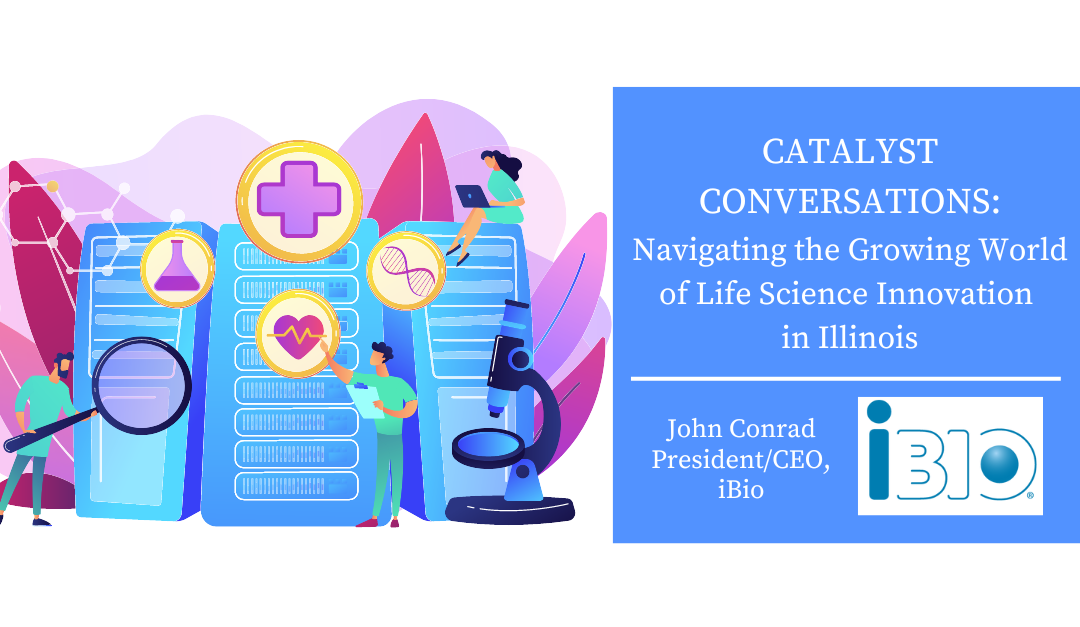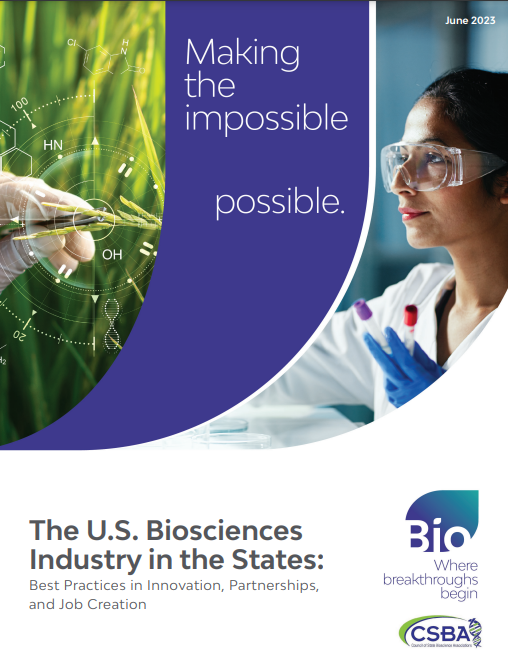CATALYST CONVERSATIONS: Navigating the Growing World of Life Science Innovation in Illinois
The life science industry is one of the fastest-growing sectors in the U.S., and Illinois is playing a major role in this growth. The state is home to a thriving ecosystem of life science companies, from startups to Fortune 500s, as well as world-class universities and research institutions.
In 2021, the Illinois life science industry employed over 579,000 people and generated $98 billion in economic output. The industry is also a major driver of innovation, with Illinois companies responsible for developing new drugs, medical devices, and diagnostics.
John Conrad is the President and CEO at iBIO, the association representing the nearly 91,000 biosciences jobs in Illinois. As President and CEO of iBIO, John’s mission is to promote, connect and engage the members of the Illinois Life Sciences community to drive discovery, transform lives through groundbreaking research and grow the Illinois economy.

John Conrad
President/CEO
iBio
Can you describe the current state of Life Science innovation in Illinois and iBio’s role in supporting the industry?
The life sciences industry in Illinois is going through a period of growth and significant change in the innovation ecosystem. Historically, our community in Illinois has been comprised mostly of global life sciences companies. Over the past five years, our startup ecosystem’s growth has been amazing. At iBIO we are focused on supporting the development of the startup life sciences ecosystem through improved policy at the state and federal level while also aligning industry resources to support startups in the community.
Life science companies often need significant amounts of capital to fund research and development. What are some ways that small and early-stage companies can rise above and attract investment?
Access to capital for startups is especially challenging right now, but we are starting to see promising signs that we are on track to return to a more normal fundraising market. Early-stage companies must leverage non-dilutive funding opportunities and programs like the Illinois Department of Commerce and Economic Opportunities SBIR Matching program and Angel Tax Credit program to bridge the gap between funding rounds. Fortunately, our startups are more resilient in Illinois and well-versed in bootstrapping.
“The research and development happening in Illinois is critical not just to our state economy, but to patients around the globe who benefit from the incredible breakthroughs that started right here.”
– John Conrad
Research and development is key to staying competitive. What are the key elements that support a strong R&D strategy and implementation?
R&D in the life sciences industry represents a significant investment with higher risks and rewards. However exciting it may be to conduct research on next-gen therapies or medical devices, ideas may be too quickly adopted as projects begin without a thorough investigation, resulting in wasted time and resources. We have seen too many examples on the coasts of companies attracting significant investments and accelerating their research only to fail in late stages. Companies need to get back to basics, set realistic milestones and follow best practices.
With a growing life science sector in Illinois, the demand for your specific talent pool is increasing. What resources do you find useful in identifying talent for the life science industry? Have you seen efforts to develop the talent pipeline for life science skills emerge?
Illinois is experiencing rapid growth in its life sciences industry, leading to intense competition for sought-after tech talent. However, as we expand, all Illinois residents must have access to these well-paying and exciting jobs. According to a recent study by iBIO and the Council of State Biosciences Institutes, more than 65% of life sciences job postings in Illinois demand a four-year or advanced degree. Thankfully, our state’s renowned academic research institutions provide a strong talent pool for these positions. The study revealed that 21% of industry roles only require a high school diploma or associate’s degree. As Illinois looks to continue supporting the industry’s growth, biopharma training (and retraining) programs for these jobs will be critical.
There are significant conversations being had about regulation in the life sciences and healthcare when we look at policies influencing innovation. Can you talk to us about how regulation impacts the industry?
Unintended consequences of policies in the life sciences industry can have far-reaching effects on the ecosystem. Startups and growth-stage companies comprise 80% of this industry and are crucial in advancing medical innovations. However, recent regulations targeting larger companies are causing disruptions that impact funding and partnerships for smaller companies. For instance, the Inflation Reduction Act 2022 allows price controls on certain drugs but discourages investment in small-molecule drugs and therapies for rare diseases. This law gives biologics a longer period without price controls, disadvantaging small molecule drugs that have significant benefits, especially for conditions like Alzheimer’s and brain cancer. These drugs not only lost valuable time for investment, but they also lost the opportunity to impact patients’ lives positively. Large companies will adjust their R&D focus away from these drugs as will venture capitalists.
Illinois businesses face increasing global competition when it comes to life sciences and other tech industries. What are some of the ways you believe Illinois businesses can get and stay ahead of global competitors?
Access to talent and capital are critical to keep Illinois competitive in the global marketplace. Focusing on talent that builds the innovation ecosystem and ensuring funding for that ecosystem will fuel continued growth in Illinois.


